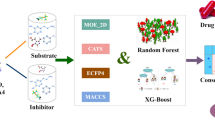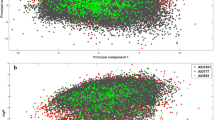Abstract
In the development of novel pharmaceuticals, the knowledge of how many, and which, Cytochrome P450 isoforms are involved in the phase I metabolism of a compound is important. Potential problems can arise if a compound is metabolised predominantly by a single isoform in terms of drug–drug interactions or genetic polymorphisms that would lead to variations in exposure in the general population. Combined with models of regioselectivities of metabolism by each isoform, such a model would also aid in the prediction of the metabolites likely to be formed by P450-mediated metabolism. We describe the generation of a multi-class random forest model to predict which, out of a list of the seven leading Cytochrome P450 isoforms, would be the major metabolising isoforms for a novel compound. The model has a 76% success rate with a top-1 criterion and an 88% success rate for a top-2 criterion and shows significant enrichment over randomised models.







Similar content being viewed by others
References
Kantae V, Krekels EHJ, Esdonk MJV et al (2017) Integration of pharmacometabolomics with pharmacokinetics and pharmacodynamics: towards personalized drug therapy. Metabolomics 13:9. https://doi.org/10.1007/s11306-016-1143-1
Tyzack JD, Hunt PA, Segall MD (2016) Predicting regioselectivity and lability of cytochrome P450 metabolism using quantum mechanical simulations. J Chem Inf Model 56:2180–2193
Zanger UM, Schwab M (2013) Cytochrome P450 enzymes in drug metabolism: regulation of gene expression, enzyme activities, and impact of genetic variation. Pharmacol Ther 138:103–141
Kirchmair J, Göller AH, Lang D, Kunze J, Testa B, Wilson ID, Glen RC, Schneider G (2015) Predicting drug metabolism: experiment and/or computation? Nat Rev Drug Discov 14:387–404
Rostkowski M, Spjuth O, Rydberg P (2013) WhichCyp: prediction of cytochromes P450. Inhib Bioinform 29:2051–2052
ACD/Labs Percepta platform (2017) http://www.acdlabs.com/products/percepta/ Accessed 6 Sept 2017
MetaPred website (2017) http://crdd.osdd.net/raghava/metapred/ Accessed 6 Sept 2017
Mishra NM, Agarwal S, Raghava GPS (2010) Prediction of cytochrome P450 isoform responsible for metabolizing a drug molecule. BMC Pharmacol 10:8
Hagymási K, Müllner K, Herszényi L, Tulassay Z (2011) Update on the Pharmacogenomics of proton pump inhibitors. Pharmacogenomics 12:873–888
García-Suástegui WA, Ramos-Chávez LA, Rubio-Osornio M, Calvillo-Velasco M, Atzin-Méndez JA, Guevara J, Silva-Adaya D (2017) The role of CYP2E1 in the drug metabolism or bioactivation in the brain. Oxid Med Cell Longev 2017(4680732):14
Wang B, Zhou SF (2009) Synthetic and natural compounds that interact with human cytochrome P450 1A2 and implications in drug development. Curr Med Chem 16:4066–4218
van der Maaten L, Hinton G (2008) Visualizing high-dimensional data using t-SNE. J Mach Learn Res 9:2579–2605
Breiman L (2011) Random forests. Mach Learn 45:5–32
StarDrop landing page on the Optibrium website (2017) http://optibrium.com/stardrop/. Accessed 6 Sept 2017
Abraham MH, McGowan JC (1987) The use of characteristic volumes to measure cavity terms in reversed-phase liquid-chromatography. Chromatographia 23:243–246
Preissner SC, Hoffmann MF, Preissner R, Dunkel M, Gewiess A, Preissner S (2013) Polymorphic cytochrome P450 enzymes (CYPs) and their role in personalized therapy. PLoS ONE 8:e82562
Fogelman SM, Schmider J, Venkatakrishnan K, von Moltke LL, Harmatz JS, Shader RI, Greenblatt DJ (1999) O- and N-demethylation of Venlafaxine in vitro by human liver microsomes and by microsomes from cDNA-Transfected cells: effect of metabolic inhibitors and. SSRI Antidepressants Neuropsychopharmacol 20:480–490
Acknowledgements
This research has received funding from the Union Seventh Framework Programme 2013 under the Grant agreement no. 602156.
Author information
Authors and Affiliations
Corresponding author
Ethics declarations
Conflict of interest
Matthew Segall and Peter Hunt are current employees of Optibrium Ltd., which develops the StarDrop software in which the methods described herein are implemented. Jonathan Tyzack is a former employee of Optibrium Ltd.
Electronic supplementary material
Below is the link to the electronic supplementary material.
Rights and permissions
About this article
Cite this article
Hunt, P.A., Segall, M.D. & Tyzack, J.D. WhichP450: a multi-class categorical model to predict the major metabolising CYP450 isoform for a compound. J Comput Aided Mol Des 32, 537–546 (2018). https://doi.org/10.1007/s10822-018-0107-0
Received:
Accepted:
Published:
Issue Date:
DOI: https://doi.org/10.1007/s10822-018-0107-0




